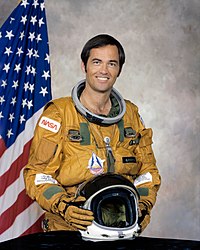Robert Crippen
| Robert Crippen | |
|---|---|

|
|
| Country: | United States |
| Organization: | USAF / NASA |
| selected on | June 30, 1966 (2nd MOL group) August 14, 1969 (7th NASA group) |
| Calls: | 4 space flights |
| Start of the first space flight: |
April 12, 1981 |
| Landing of the last space flight: |
October 13, 1984 |
| Time in space: | 23d 13h 46m |
| retired on | December 31, 1991 |
| Space flights | |
Robert Laurel "Bob" Crippen (born September 11, 1937 in Beaumont , Texas , USA ) is a former astronaut in the US Air Force and the US space agency NASA .
resume
Crippen grew up in Porter, Texas. He graduated from New Caney High School in New Caney, Texas and received a bachelor's degree in aerospace engineering from the University of Texas in 1960 .
Crippen trained as a marine pilot in Florida and Texas. From June 1962 to November 1964 he was assigned to the Fleet Squadron VA-72 as a pilot on board the aircraft carrier USS Independence . He then attended the USAF Aerospace Research Pilot School at Edwards Air Force Base , California, and remained there until his selection into the USAF Manned Orbiting Laboratory (MOL) program in June 1966. Crippen was in the second group of pilots enrolled in the MOL- Program. When the Air Force abandoned its manned space program, 7 of its 17 astronauts, including Crippen, were taken over by NASA.
Astronaut activity
He was a member of the support team (Support Crew) for the missions Skylab 2 , Skylab 3 and Skylab 4 , as well as for the Apollo Soyuz Test Project (ASTP), which was successfully completed in July 1975.
STS-1
On April 12, 1981, Crippen started as a pilot of Columbia for the first space shuttle mission STS-1 . It was the first space flight of a reusable spacecraft. STS-1 was commanded by John Young .
NASA described the STS-1 as "the boldest test flight in history".
STS-7
For the second mission of the Challenger , Crippen started on June 18, 1983 as commander. It was the first mission with a crew of five. During the six-day flight the satellites ANIK C-2 and PALAPA B-1 were deployed . In addition, the research platform SPAS-01 was released and recaptured for the first time with the robotic arm (RMS) . STS-7 was the first flight by an American woman ( Sally Ride ) into space.
STS-41-C
During the seven-day mission in April 1984, Crippen again worked as a commander on the Challenger. A highlight of the mission was the repair of the Solar Maximum Mission (SMM) satellite in orbit. In addition, the Long Duration Exposure Facility (LDEF) was suspended with 57 experiments and recaptured and brought back to Earth in a later mission.
STS-41-G
As commander of the Challenger, Crippen started on October 5, 1984 for the first time with a crew of seven. It was the first flight with two female crew members ( Sally Ride and Kathryn Sullivan ).
STS-62-A
Crippen was designated as the commander for the first launch of a space shuttle from the SLC-6 launch complex at Vandenberg Air Force Base . However, after the Challenger disaster , this mission was not carried out.
Further activities at NASA
After his active astronaut work, Crippen became the deputy director of Shuttle Operations at the Kennedy Space Center (KSC) in 1986 , where he was responsible for shuttle preparation and mission execution, as well as for the return of the orbiters from Edwards Air Force Base to KSC. In January 1990 Crippen became director of NASA headquarters in Washington, DC From January 1992 he was director of the Kennedy Space Center (KSC) in Florida for 3 years, where he was responsible for 22 flights of the space shuttle.
According to NASA
From April 1995, Crippen was Vice President of Lockheed Martin Information System and in December 1996 moved as President to Morton Thiokol , now part of the defense and aviation company Alliant Techsystems as ATK's Launch Systems Group .
Special features and records
- first space shuttle flight ( STS-1 )
- first person to go into space with a solid rocket drive ( STS-1 )
- first landing of a spacecraft in gliding flight ( STS-1 )
- first space mission with five crew members ( STS-7 )
- first space mission with seven crew members ( STS-41-G )
- first person to fly four times on a space shuttle
Honors
2006 Crippen was awarded the Congressional Space Medal of Honor on the occasion of the 25th anniversary of the first space shuttle flight STS-1 . John Young , the commander of STS-1, had received the same award for this mission in 1981.
See also
- List of space shuttle missions
- List of manned space flights
- List of spacemen
- Space shuttle
- Manned space travel
Web links
- Short biography of Robert Crippen at spacefacts.de
- NASA biography of Robert Crippen (English; PDF)
- Biography of Robert Crippen in the Encyclopedia Astronautica (English)
- Transcript of a 2006 NASA interview in the JSC Oral History Project (English)
Individual evidence
- ^ NASA biography of Robert Crippen , accessed June 26, 2013 (PDF).
| personal data | |
|---|---|
| SURNAME | Crippen, Robert |
| ALTERNATIVE NAMES | Crippen, Robert Laurel; Crippen, Bob (nickname) |
| BRIEF DESCRIPTION | American astronaut |
| DATE OF BIRTH | September 11, 1937 |
| PLACE OF BIRTH | Beaumont , Texas, United States |